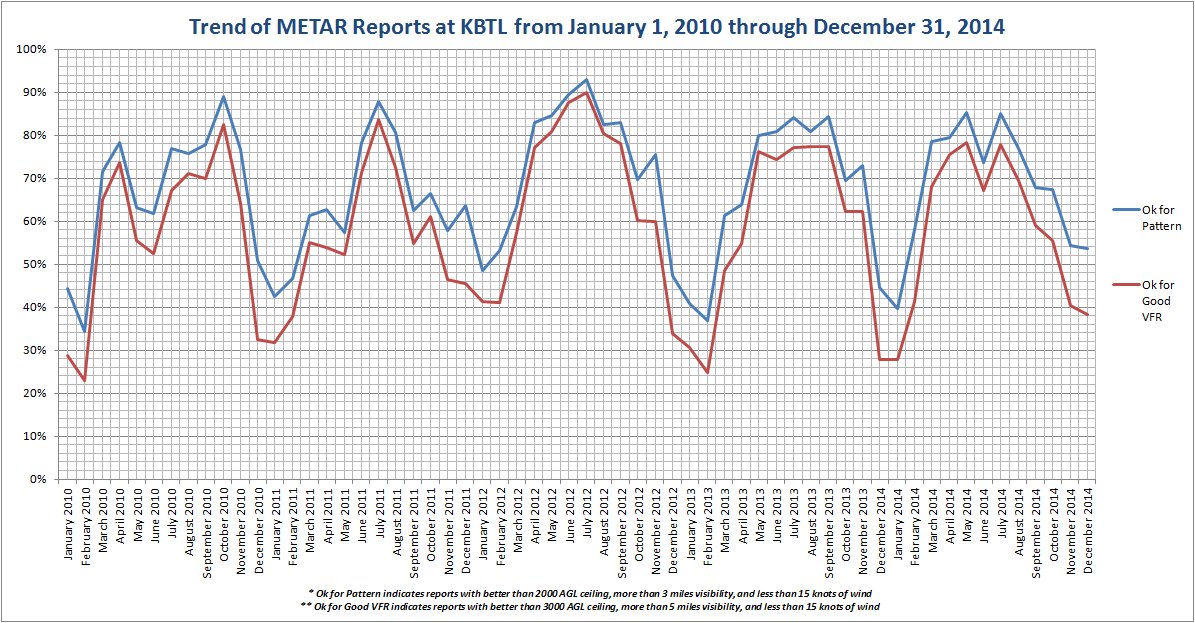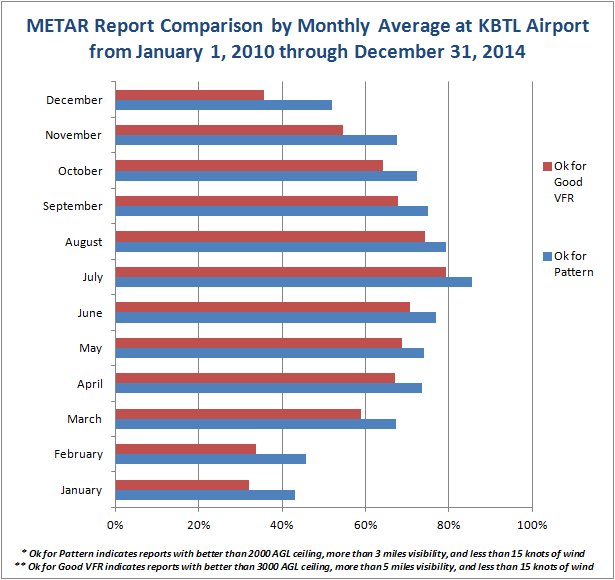Flying in the summer months at Battle Creek, Michigan is, on average, almost 40% more likely to result in experiencing weather conditions that allow flight training to be successfully completed.
Flying when the weather is better allows more flight training to be completed. This is a simple statement, but many don’t really look into the details of what it means. While I spent some time working on an article comparing weather at sites across the country in relation to flyable weather conditions for flight training, I drilled down the numbers in much greater detail for Battle Creek because it is home, it is information that directly affects students and instructors I personally know, and the data that I found was strongly trended.
This chart shows the trends of ups and downs that are experienced when broken down by average METAR reports at Battle Creek, Michigan between 2010 and 2015. The trends are pretty obvious.
Winter months in Battle Creek have significantly worse weather than summer months. While this is something we all knew anecdotally, now we have the math to prove it.
Many WMU students spend Winter and Spring semesters training, then take off the Summer semester. If training efficiency is important, this is probably most important semester of a school year that should be focused on to complete the most training in the shortest periods of time with the least amount of weather delays.
If you don’t think it is important, think about it in a broader career perspective. Sure, students have 4 years to complete their training if they plan on completing a degree, but getting through flight training early in those 4 years can have a significant positive effect on an overall flying aviation career. A student that gets through their private, instrument, commercial (single- and multi-engine) and their CFI early has an opportunity to instruct as they finish their last year or two of coursework. This transition is important if a pilot is focused on getting enough flight time to meet ATP minimums (even restricted ATP requirements).
Follow me through this. A pilot that gets their training done by, for example, the end of their Junior year has an opportunity to accumulate instructional flight hours during their Senior year, helping them get valuable flight time (and let’s be honest, getting paid to do it is not a bad thing either) that will be applicable to hiring minimums later. Any delay in getting these hours pushes a hiring date with an airline (or any other commercial pilot job that requires an ATP) further into the future. Every month, year, or decade of delay means lower career earnings potential.
If the monthly trend graph above didn’t help you see it, how about this one that shows the data on an averaged monthly basis for these years:
Again, this shows the high points of good weather as during summer months.
If I were looking to training in Battle Creek, or I had a son or daughter doing so, I would look to try to find a way to make sure my education at WMU became a year round effort, not just Winter and Spring semesters when the weather is sure to force delays in training. My money would be on making sure I was doing some flight training through the Summer semesters.
 It’s a bit dorky to drill down this math, but it is highly illustrative of our local weather conditions and how they can affect out training environment.
It’s a bit dorky to drill down this math, but it is highly illustrative of our local weather conditions and how they can affect out training environment.
Want to know more about the math behind it? Well here it is (in case you want more detail). To get this data, I pulled every METAR report from January 1, 2010 through December 31, 2014 and compared them. The percentages given in this data are equated to “Ok for Pattern” and “Ok for Good VFR” labels. “Ok for Pattern” means a METAR reported ceilings better than 2000′ AGL, visibility better than 3 miles, and less than 15 knots winds. “Ok for Good VFR” means a METAR reported ceilings better than 3000′ AGL, visibility better than 5 miles, and less than 15 knots winds. These two broad characterizations are basic considerations of whether a pilot trying to fly (or train) could either fly traffic pattern or go out to a practice area to do most training maneuvers prescribed in practical test standards. I didn’t bother trying to analyze if instrument training could be completed because so much of the time in the winter when there are clouds, icing is present, and we can’t fly anyway.
The data reports in percentages indicate the percentage of reports in each month or the averaged month that meet the established criterion.
 When considering these data points on a monthly trend or as an average for each month over the years, the trends follow a pattern that matches our anecdotal experience.
When considering these data points on a monthly trend or as an average for each month over the years, the trends follow a pattern that matches our anecdotal experience.
The key is now that we have the data, trying to use it to change how we view the pursuit of training in our environment.
I doubt that WMU’s College of Aviation will discourage students from staying around for summer weather training. In fact, I would bet it would be welcomed.


